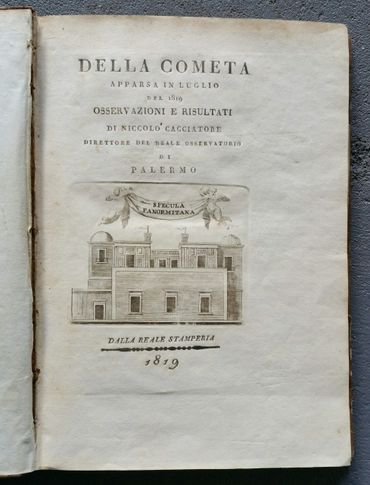Astronomy and Optics (Post-1800)
the great comet of july 1819 observed by piazzi’s successor at the royal observatory, palermo


CACCIATORE, Niccolò. Della Cometa apparsa in luglio del 1819 osservazioni e risultati. [Palermo], della Reale Stamperia, 1819.
£1400
Presentation copy of the very rare first edition of Cacciatore’s observations of the comet of 1819, one of the finely produced publications printed by the Reale Stamperia on behalf of the observatory.
The Great Comet of 1819, an easily visible, exceptionally bright comet, was discovered on July 1, by Johann Georg Tralles in Berlin, Germany. Visible in Palermo only from July 3, Cacciatore began his observations on that date, ending on August 11, 1819.
Besides extensive tables documenting the comet’s progress and path, he records barometric readings, and temperature.
the great comet of 1843


CALANDRELLI, Ignazio. Sulla gran cometa apparsa nel marzo dell’anno 1843. Rome, Giovanni Olivieri, 1844.
£750
Presentation copy of the rare first edition of Calandrelli’s publication on the Great Comet of 1843.
Ignazio Calandrelli (1792-1866) took a degree in philosophy in 1814 and in the same year became a student at the observatory of the Collegio Roman, where his uncle was director. He concentrated on planetary observations, and the Great Comet of 1843.
In 1845 he moved to Bologna, where he was appointed professor of astronomy and director of the observatory. He later was called back to Rome by Pope Pius IX and became director of the Campidoglio Observatory.
OPTICAL INSTRUMENTS
SANTINI, Giovanni. Teorica degli stromenti ottici destinati ad estendere i confine della visione naturale. Padua, nella Tipografia del Seminario, 1827-1828.
Sold
First edition of Santini's comprehensive work on optical instruments.
‘Giovanni Santini wrote this treatise on optical instruments, principally the telescope, to present the practical aspects of the theory of lens design for the Italian optics industry ...
‘Something for both the scholar and the optician. The two volumes separate the theory and development of lens design and construction, from descriptions of telescopes and microscopes. The material is entirely analytic, the practical aspects of glass cutting, grinding, figuring, and polishing are not considered. Santini’s work, especially volume I, was a significant influence on Italian opticians, particularly Giovanni Battisti Amici and Ottaviano Fabrizio Mossotti. It was also influential with Joseph Johann Littrow at the Vienna observatory’ (DiLaura, Bibliotheca Opticoria, p. 660).
solar observations and a new barometer
SECCHI, Angelo. Relazione delle osservazioni fatte in Spagna durante l’eclisse totale del 18 Luglio 1860. Rome, Tipografia delle Belle Arti, 1860. [bound with at the end:] Sopra un nuovo barometro. Rome, Tipografia delle Belle Arti, 1857.
£650
First edition of Secchi’s observations of the total solar eclipse of July 1860, illustrated by two fine plates.
‘Secchi realized the importance of observing the chromosphere and the corona during total eclipses of the sun. His first opportunity to do so occurred in 1860, when the totality of a solar eclipse was visible in Spain … He made observations with a Cauchoix refractor; he then compared his results with those De la Rue had made with a Kew photoheliograph at Rivabellosa. Secchi thus concluded that the prominences seen during the eclipse were real, rather than a play of light as some had suggested; that they were solar in origin; and that the corona was also real and thicker at the equator than at the poles, and thickest at forty-five degrees …’ (DSB).
Appended here is an offprint of a brief paper by Secchi on a new, improved barometer, published at Rome in 1857.